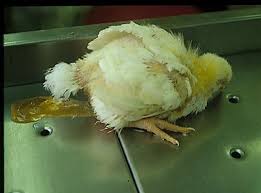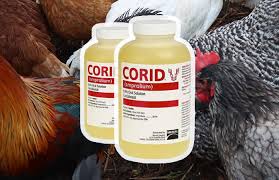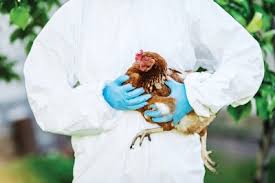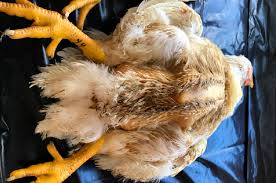Coccidiosis in broilers is a common parasitic disease caused by protozoan parasites of the genus Eimeria. This condition primarily affects young chickens and can lead to significant economic losses for poultry farmers due to decreased growth rates, increased feed conversion ratios, and higher mortality rates. Coccidiosis is particularly problematic in intensive farming systems where birds are kept in close confinement, creating ideal conditions for the spread of the parasite.
The disease manifests in various forms, with symptoms ranging from mild diarrhea to severe intestinal damage, depending on the species of Eimeria involved and the age of the affected birds. Understanding the treatment and prevention strategies for coccidiosis is crucial for maintaining flock health and optimizing production.
To effectively treat coccidiosis, it is important to first recognize the signs of infection. Common symptoms include lethargy, ruffled feathers, reduced feed intake, and diarrhea that may contain blood or mucus. Early detection is key to successful intervention, as the disease can progress rapidly if left untreated. Farmers should routinely monitor their flocks for these signs and implement biosecurity measures to prevent the introduction and spread of the parasite.
One of the primary treatment methods for coccidiosis in broilers involves the use of anticoccidial medications. These drugs can be administered through the feed or water and are designed to inhibit the growth and reproduction of the Eimeria parasites. Common anticoccidials include ionophores, such as monensin and lasalocid, as well as synthetic drugs like sulfonamides and toltrazuril.
The choice of medication often depends on the specific Eimeria species present, the severity of the outbreak, and the age of the birds. It is essential to follow the manufacturer’s guidelines regarding dosage and duration of treatment to ensure effectiveness while minimizing the risk of drug resistance.
In addition to pharmacological treatments, supportive care plays a crucial role in managing coccidiosis in broilers. Providing clean, dry bedding and adequate ventilation helps reduce stress on the birds and limits the spread of infection. Ensuring that birds have access to fresh water and a balanced diet can also promote recovery. In severe cases, electrolyte solutions may be provided to dehydrated birds to restore fluid balance and improve overall health.
Prevention is often more effective than treatment when it comes to coccidiosis. Implementing a comprehensive management plan can help minimize the risk of outbreaks.
This includes maintaining strict biosecurity protocols, rotating anticoccidial treatments to prevent resistance, and practicing good sanitation by regularly cleaning and disinfecting equipment and housing areas. Additionally, vaccinating broilers against coccidiosis can provide long-term protection, reducing the reliance on medication and enhancing flock health.
Identifying Symptoms of Coccidiosis
1. Diarrhea: One of the most noticeable symptoms is diarrhea, which can be watery or bloody, indicating damage to the intestinal lining.
2. Weight Loss: Infected chickens often experience significant weight loss due to reduced feed intake and nutrient absorption.
3. Lethargy: Affected birds may appear tired and less active than usual, showing signs of fatigue.
4. Ruffled Feathers: Chickens with coccidiosis often have ruffled feathers, a sign of discomfort or illness.
5. Poor Feed Conversion: Birds may eat normally but fail to gain weight, leading to poor growth rates.
Causes of Coccidiosis in Broilers

1. Protozoan Parasites: The primary cause is infection by Eimeria species, which are the protozoan parasites responsible for coccidiosis.
2. Environmental Contamination: Coccidia oocysts can survive in litter and soil, allowing for reinfection, especially in crowded or unhygienic conditions.
3. Stress Factors: Stressful conditions, such as overcrowding, poor ventilation, and abrupt temperature changes, can increase susceptibility.
4. Poor Nutrition: Inadequate or imbalanced diets can weaken the immune system, making birds more vulnerable to infections.
5. Age of Birds: Younger broilers are more susceptible due to their underdeveloped immune systems, particularly those under 6 weeks old.
Diagnosis of Coccidiosis
1. Clinical Observation: Diagnosis often begins with observing symptoms like diarrhea, weight loss, and lethargy in the flock.
2. Fecal Examination: Microscopic examination of fecal samples can reveal the presence of coccidia oocysts, confirming infection.
3. Post-Mortem Examination: In severe cases, a necropsy may be conducted to identify intestinal lesions characteristic of coccidiosis.
4. Histopathological Analysis: Tissue samples from affected birds can be analyzed to assess the extent of intestinal damage caused by coccidia.
5. Laboratory Tests: In some cases, blood tests or other laboratory evaluations may be needed to rule out other diseases.
Preventive Measures for Coccidiosis
1. Good Hygiene Practices: Regular cleaning of coops, feeding areas, and water sources helps minimize contamination.
2. Proper Waste Management: Frequent removal of droppings and old litter can reduce the buildup of coccidia oocysts.
3. Controlled Density: Avoid overcrowding in poultry housing to minimize stress and disease transmission.
4. Balanced Nutrition: Providing a well-balanced diet rich in essential nutrients helps bolster the immune system of broilers.
5. Vaccination: Implementing a vaccination program against coccidiosis can help build immunity in young birds.
6. Biosecurity Measures: Establishing strict biosecurity protocols, including limiting access to the poultry area and sanitizing equipment, can help prevent the introduction of coccidia.
Choosing the Right Medication
1. Consultation with a Veterinarian: Always consult with a veterinarian to identify the most effective medication based on the specific strain of Eimeria affecting your flock.
2. Type of Coccidiostat: Select medications classified as coccidiostats, which specifically target coccidia without harming the birds.
3. Route of Administration: Consider the method of administration (oral, water, or feed) that is most convenient and effective for your management system.
4. Withdrawal Period: Be aware of the withdrawal period for any medication used to ensure no drug residues remain in the meat or eggs.
5. Resistance Management: Choose medications that have been effective historically and rotate them to prevent the development of drug-resistant strains of coccidia.
Read Also: 14 Health Benefits of Using Lemon Pepper Seasoning on your Cooking
Medications for Treating Coccidiosis

1. Sulfonamides: Medications like sulfadimethoxine are commonly used to treat coccidiosis, acting as coccidiostats to inhibit the growth of Eimeria.
2. Ionophores: Compounds like monensin and salinomycin are used as feed additives that help control coccidia without significant side effects.
3. Amprolium: This medication interferes with coccidia metabolism, making it effective for treating and preventing coccidiosis.
4. Tetracyclines: In some cases, tetracycline antibiotics may be prescribed to address secondary bacterial infections alongside coccidiosis treatment.
5. Natural Remedies: Some producers opt for herbal or natural treatments, but these should be used with caution and under veterinary guidance.
Administering Treatment to Broilers
1. Water Medication: If administering medication through water, ensure birds have access to clean, uncontaminated water for proper intake.
2. Feed Medication: Mix the medication thoroughly into the feed, ensuring even distribution so all birds receive the proper dosage.
3. Monitoring Intake: Observe the flock to ensure they are consuming the treated feed or water adequately, adjusting as necessary.
4. Duration of Treatment: Follow the recommended treatment duration as specified by the veterinarian or on the medication label.
5. Isolation of Affected Birds: If possible, isolate severely affected birds to monitor their recovery and prevent the spread of the disease.
Nutritional Support During Treatment
1. Balanced Diet: Provide a nutritionally balanced diet that includes essential vitamins and minerals to support recovery.
2. Increased Fiber: Adding fiber-rich feeds can aid digestion and improve gut health during and after treatment.
3. Electrolyte Solutions: Offer electrolyte solutions in drinking water to prevent dehydration and support hydration during treatment.
4. Probiotics: Introducing probiotics can help restore gut health and promote a healthy gut microbiome after medication.
5. Frequent Feedings: Consider providing smaller, more frequent feedings to encourage appetite and nutrient intake during recovery.
Read Also: The Health Benefits of Using Mexican Seasoning on your Cooking
Managing Environmental Conditions

1. Temperature Control: Maintain optimal temperature ranges to ensure broilers are comfortable and reduce stress, which can hinder recovery.
2. Humidity Levels: Keep humidity levels balanced to prevent respiratory issues and promote a healthy environment for recovery.
3. Ventilation: Ensure adequate ventilation to provide fresh air, reduce ammonia buildup, and maintain a healthy atmosphere in the housing.
4. Sanitation: Regularly clean and disinfect housing, feeding equipment, and water sources to minimize the risk of reinfection.
5. Lighting: Utilize proper lighting schedules to encourage natural behaviors and reduce stress among the birds.
Monitoring Recovery Progress
1. Observation of Symptoms: Regularly check for signs of improvement or persistence of symptoms, such as appetite, energy levels, and fecal consistency.
2. Weight Tracking: Weigh birds weekly to assess recovery and ensure they are regaining lost weight during treatment.
3. Behavioral Changes: Monitor for behavioral improvements, such as increased activity and social interactions, which indicate recovery.
4. Veterinary Follow-Up: Schedule follow-up consultations with a veterinarian to evaluate recovery and adjust treatment plans if necessary.
5. Flock Health Assessments: Conduct regular flock health assessments to identify any lingering issues or signs of secondary infections.
Post-Treatment Care and Prevention
1. Gradual Reintroduction to Feed: Slowly transition birds back to their regular feed after treatment to avoid digestive upset.
2. Continued Nutritional Support: Maintain a high-quality, balanced diet for recovering birds to support overall health and immunity.
3. Monitoring for Relapse: Keep an eye on birds for signs of coccidiosis recurrence and respond quickly to any new symptoms.
4. Biosecurity Measures: Reinforce biosecurity protocols to prevent exposure to coccidia, including controlling access to poultry areas.
5. Vaccination: Consider implementing a vaccination program to enhance immunity against coccidiosis in future flocks.
Do you have any questions, suggestions, or contributions? If so, please feel free to use the comment box below to share your thoughts. We also encourage you to kindly share this information with others who might benefit from it. Since we can’t reach everyone at once, we truly appreciate your help in spreading the word. Thank you so much for your support and for sharing!
Read Also: How To Educate Yourself On Climate Change






